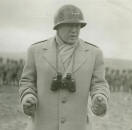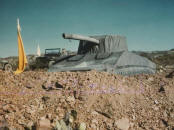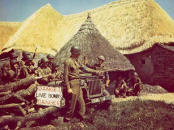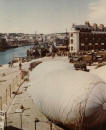The army General George Patton fielded for the 1944 Normandy D-Day Invasion was unlike any other. It was a complete and unabashed fake.
Brian John Murphy
From a distance, an English farmer could see that sometime overnight a column of Sherman tanks had parked on his field. One of his bulls also noticed the American tanks and was eyeing one of them warily. Suddenly, the bull lunged. The farmer braced himself for the sight of one of his prized bovines cracking its skull against armor plating.
The bull struck the tank at top speed, and with a lazy hiss of air, the Sherman deflated into a pile of olive-drab rubber sheeting. The bull and the farmer had stumbled onto one of the most elaborate deceptions in the history of warfare: the creation of a phantom army to divert attention from the real Allied army poised to invade France in the spring of 1944.
 It was widely understood, even before the disastrous British and Canadian raid on the French port of Dieppe on August 19, 1942, that any attempt to crack Adolf Hitler’s Fortress Europa would be a chancy venture at best. Any amphibious or airborne invasion is full of risks, but by 1943 both sides knew the Allies had no alternative if they were going to defeat Hitler. And it was the only way the Allies could make good on their promise to the Soviet Union to create a second front on land for the Germans to defend.
It was widely understood, even before the disastrous British and Canadian raid on the French port of Dieppe on August 19, 1942, that any attempt to crack Adolf Hitler’s Fortress Europa would be a chancy venture at best. Any amphibious or airborne invasion is full of risks, but by 1943 both sides knew the Allies had no alternative if they were going to defeat Hitler. And it was the only way the Allies could make good on their promise to the Soviet Union to create a second front on land for the Germans to defend.
Northern France was the obvious target, but the Allies had other options, too. So, once they settled on northern France, it became their goal to lead the German high command—especially Hitler—to believe they would do the unexpected and land somewhere else. British intelligence agencies set to work, launching an enormous deception campaign called Bodyguard, designed to make the Germans believe the invasion might come in Greece, on the Adriatic coast of Yugoslavia, in the south of France, on the Biscay Bay coast of France, through the Low Countries, or via Norway and Denmark.
The Germans took all these possible scenarios seriously and maintained garrisons in all those regions. This helped the Allies in two ways: the garrisons guarding the possible invasion sites were removed from the fighting in the Soviet Union, which helped the Russians—and they were not concentrated in northern France, where the Allies really were going to attack.
 Unfortunately, as 1943 wore on, it became obvious that the buildup of American, Canadian, and British forces in England and Scotland portended an invasion of northern Europe, most likely into northern France, along the coast of the English Channel. What the Germans needed to know was where the landing, or landings, would strike. Would the Allies cross the channel at its narrowest point and attack the port of Calais? Would the attacks fall on Cherbourg and Le Havre? Some German generals believed the blow would come not at these ports but perhaps on the coast of Normandy. Ominously, Hitler shared that view, and ordered the defenses there to be beefed up.
Unfortunately, as 1943 wore on, it became obvious that the buildup of American, Canadian, and British forces in England and Scotland portended an invasion of northern Europe, most likely into northern France, along the coast of the English Channel. What the Germans needed to know was where the landing, or landings, would strike. Would the Allies cross the channel at its narrowest point and attack the port of Calais? Would the attacks fall on Cherbourg and Le Havre? Some German generals believed the blow would come not at these ports but perhaps on the coast of Normandy. Ominously, Hitler shared that view, and ordered the defenses there to be beefed up.
The Allies did plan to invade at Normandy, and they came up with an elaborate plan that included making an artificial harbor. Codenamed Mulberry, the harbor would consist of concrete caissons sunk offshore to create breakwaters and piers. All this could be for naught, however, if Germany’s massive infantry and panzer reserves garrisoning France’s Pas de Calais region were brought into the battle in Normandy. The Allies had to find a way to threaten the Pas de Calais before, during, and after the proposed invasion. If the threat were credible, Hitler would not realize it was safe to move his reserves into Normandy to combat the Allied thrust.
 At this point, Allied intelligence services came in, principally the British. They developed a plan called Fortitude by which; they would create two phantom army commands—one in Scotland to threaten an invasion of Norway, and the other in East Anglia and southeast England to threaten the Pas de Calais. The latter operation, known as Quicksilver, would establish an imaginary army group designated the First US Army Group (FUSAG). The commander of this ghost army had to be a general renowned enough to make the operation seem thoroughly credible to the Germans—a real blood and guts general. Lieutenant General George S. Patton was the perfect choice, and he was available.
At this point, Allied intelligence services came in, principally the British. They developed a plan called Fortitude by which; they would create two phantom army commands—one in Scotland to threaten an invasion of Norway, and the other in East Anglia and southeast England to threaten the Pas de Calais. The latter operation, known as Quicksilver, would establish an imaginary army group designated the First US Army Group (FUSAG). The commander of this ghost army had to be a general renowned enough to make the operation seem thoroughly credible to the Germans—a real blood and guts general. Lieutenant General George S. Patton was the perfect choice, and he was available.
Patton had made himself available for the role by becoming a public relations liability during his brilliant campaign to invade Sicily in 1943. On two separate occasions Patton had slapped soldiers taken from the front lines to be treated for combat fatigue. The resulting firestorm in the press led to Patton’s being relieved of command. So instead of commanding troops on campaign in Italy, Patton was ordered to participate in a series of junkets around the Mediterranean, making speeches, inspecting facilities, and having his picture taken.
Patton’s months of wandering to Corsica, Malta, and Egypt were hardly pointless. His travels bolstered the Allied deception plan at the time, which was simulating threats against the south of France (from Corsica), the Balkans (from Malta), and Greece (from Egypt). The voyages kept the Germans guessing and prevented them from deploying their reserves to advantage.
On January 26, 1944, Patton was at last brought to England—but not to command American armies in Overlord (the code name for the invasion of northern France). Thanks to the slapping incidents, Patton had lost any chance at that job to his former subordinate, Lieutenant General Omar Bradley. Instead, Patton was given the assignment of commanding the fictional FUSAG. Only after fulfilling that role would he receive command of the US Third Army when it was ready to deploy in France.
 At first, the force referred to as Army Group Patton was a phantom army composed of real units (earmarked for the command of British Lieutenant General Bernard Montgomery, but for the time being appearing in the FUSAG order of battle) and wholly fictional divisions and corps. This created the impression that the British, Canadian, and American armies gathering in England were as much as 70 percent bigger than the actual number of soldiers preparing to embark for France. Their locations in East Anglia and southeast England made it seem that the Allies were planning to go for broke and push across the narrowest part of the English Channel in a bold and costly attempt to take the port of Calais intact. If the Quicksilver operatives could pull off this imposture convincingly, the Germans would have little choice but to keep heavy forces in the Pas de Calais, even if Allied troops landed elsewhere on the French coast.
At first, the force referred to as Army Group Patton was a phantom army composed of real units (earmarked for the command of British Lieutenant General Bernard Montgomery, but for the time being appearing in the FUSAG order of battle) and wholly fictional divisions and corps. This created the impression that the British, Canadian, and American armies gathering in England were as much as 70 percent bigger than the actual number of soldiers preparing to embark for France. Their locations in East Anglia and southeast England made it seem that the Allies were planning to go for broke and push across the narrowest part of the English Channel in a bold and costly attempt to take the port of Calais intact. If the Quicksilver operatives could pull off this imposture convincingly, the Germans would have little choice but to keep heavy forces in the Pas de Calais, even if Allied troops landed elsewhere on the French coast.
The Quicksilver illusion had to be airtight. The first the Germans learned of the FUSAG forces coming their way was through a spy working in New York under the alias Albert van Loop. Van Loop had become a double agent for the Federal Bureau of Investigation (and, unknown to the bureau, had switched his loyalties back to the Germans, making him a triple agent). In September 1943, using the codes supplied to van Loop by the German intelligence service—the Abwehr—the FBI sent messages in van Loop’s name informing the Germans that the phony divisions were embarking at New York, bound for the British Isles.
As part of the ruse, an eight-inch-thick book of scripted radio transmissions was issued to Quicksilver radio operators. Whenever a phantom unit would have been arriving in Britain, making camp, and making preparations for the invasion, plenty of radio traffic would be generated to create realistic chatter for the prying ears of the Abwehr.
The Abwehr had prying eyes, too: reconnaissance planes that flew at 33,000 feet over the English countryside trying to spot FUSAG units and record their activities and movements. The British and American air forces had to be careful to let the Luftwaffe snoops through to see the mock preparations on the ground, yet not let the flights seem so easy as to raise suspicions.
On the ground, the real units earmarked for Overlord but temporarily assigned to FUSAG had no trouble appearing as though they meant business. But the imaginary units were supposed to have upwards of a million men, and they had to look active, too. This need spawned the greatest deceptive enterprise ever seen in a war. Tent cities were created all over eastern England. There were mess halls, hospitals, ammo depots, and even sewage treatment farms. Fuel depots were constructed and parks for trucks, tanks, jeeps, and ambulances were laid out. For the most part, the vehicles themselves were constructed of fabric and wood or were rubber inflatables like the Sherman tank that the farmer’s bull gored.
Real vehicles move around, of course, and under cover of darkness, that’s just what these fake vehicles did. That was how the line of tanks appeared in the farmer’s field unannounced. Besides the bogus tanks, the farmer also noticed a couple of soldiers moving odd devices around his field that day. Rubber tanks and trucks don’t leave tank tread marks in the earth, so soldiers supporting Quicksilver were equipped with rolling tools to make tread and tire marks for the Luftwaffe to see.
British intelligence concocted plenty of plausible information for neutral diplomats and operatives to see, hear, and pass along to their governments—and possibly to the Germans. Local vicars in East Anglia wrote to the local papers about the terrible behavior of some of the “foreign troops.” The US Army’s heraldry department even made unit shoulder patches up for the phantom divisions [click link to view our exclusive gallery]. Quicksilver operatives on leave in London and elsewhere wore them conspicuously on their uniforms.
The Quicksilver deception plan extended to the ports and waterways of eastern England. There were barely enough landing craft available for the real invasion of France, so with the help of experts from the British movie industry, fleets of dummy landing craft were made, and they began to choke harbors and streams. Close up, they might not have fooled anyone, but the 400 or so concoctions of fabric, plywood, old pipes, and bailing wire floating on oil drums looked convincing to Luftwaffe photographers taking pictures from 33,000 feet. At night, port areas were lit with blackout lights to simulate loading activities. Near Dover, workers put together an entire dummy oil dock from camouflage-painted board, sewage pipes, and fiberboard. King George VI visited to inspect the facility, and the lord mayor of Dover publicly mentioned it as a potential municipal asset after the war. The British Royal Air Force kept fighter patrols overhead to protect the mock dock, and workers on the ground burned smudge pots filled with crude oil to keep the facility in a haze. Because the would-be dock was within range of the German guns at Cape Gris Nez, pyrotechnics were used to simulate fires and damage from the occasional hit.
So far so good. The interception of radio signals and photo intelligence reinforced the belief among the German generals that the Allies were saving their punch for the Pas de Calais. The third element was human intelligence, and the British were well positioned to provide the Germans with plenty of misleading information.
Misleading the enemy was the specialty of the Double Cross Committee, also known as the XX Committee or Twenty Committee. This British intelligence group had a stable of double agents sending specially crafted intelligence about FUSAG to the Abwehr. As far as the Abwehr knew, the upper echelons of the Allied command structure were riddled with Nazi spies. In reality, with tremendous efficiency, the British had rounded up all the Axis spies in the United Kingdom early on and turned a surprising number of them into double agents. Others volunteered for this dangerous game.
Two of the most important British agents were Brutus and Garbo. These two men were arguably among the war’s most devastatingly effective spies. Brutus was the code name of Captain Roman Garby-Czerniawski, a former Polish general staff officer now pretending to spy for the Germans. He told the Germans he had been appointed as a liaison between Free Polish forces and Patton’s FUSAG head quarters. He provided convincing detail on behalf of the Double Cross Committee.
Garbo, a Catalan named Juan Pujol, had begun his spying career as an amateur, deceiving the Germans with false intelligence he cooked up himself. The British found out about him and brought him from Spain to England, where he went to work for the Double Cross Committee. Garbo gave the Germans the impression that he had gotten a job high up in the British government and was the spymaster of a network of 14 agents placed throughout the Allied high command and British government. He sent frequent and detailed reports on the growth and intentions of FUSAG. Those reports fooled the highest echelons of command—up to and including Hitler.
Another secret agent, code-named Tricycle (a Yugoslav named Dusko Popov), sent a detailed report in February 1944 on the FUSAG order of battle. For a few scary days German intelligence analysts in Lisbon, where Tricycle made his report, did not believe it. But when it was passed on to Berlin, the high command bought it, making it possible for further reports from other Double Cross agents to be believed.
Thanks to the British cryptologists working at Bletchley Park, the code-breaking center northwest of London (and the timely acquisition of a German Enigma code machine captured early in the war), Supreme Commander of the Allied Forces General Dwight D. Eisenhower. and the British government received decryptions of German radio traffic. The messages showed that the Nazis were buying the FUSAG deception. What intelligence people call a “closed loop” had been successfully established: the British were putting out false information about the FUSAG and then intercepting enemy communications very soon afterward that showed how well each item of deception had worked. Future deceptions were adjusted accordingly.
Valuable intelligence passed to the Germans when the last commander of the Deutsches Afrika Korps, General Hans Cramer, captured in May 1943, was exchanged back to the Germans due to poor health. On the way home he was wined and dined one evening by Patton himself, in his role as commander of FUSAG. Patton must have played the role of a somewhat loose-lipped commander well (he was in fact known to be indiscreet on occasion). Other Allied officers also let slip bits of seemingly sensitive information about FUSAG and the Pas de Calais. Cramer was put on a neutral ship for his return to Germany, where he was exhaustively debriefed. After that, the German high command was more convinced than ever that FUSAG was going to be part of an invasion at the Pas de Calais.
When the Allies invaded Normandy on D-Day, June 6,1944, the Wermarcht’s forces in Europe were still spread between active fronts in Italy and Russia and possible fronts in the Balkans, the south of France, Greece, Norway, and northern France. Bodyguard and Fortitude had succeeded in keeping the Germans guessing where the next blows would fall. The real test, however, would come after the landings. If the Germans ceased to believe in the FUSAG threat, then the substantial German forces guarding the Pas de Calais would be sent to Normandy. The result might be the failure of Overlord, a catastrophe no one wanted to think about. Quicksilver had to keep working after the invasion.
The tempo of activity in the FUSAG area quickened after June 6. As real Allied armies moved off the beaches and into the hedgerow country of Normandy, the ports of eastern England were jammed with dummy landing craft and a fair sprinkling of actual warships to create the impression that FUSAG was about to embark for Calais. At night the blackout lights were lit on docks and quays to simulate the loading of materiel and supplies for the Pas de Calais landings. Radio transmission points, which had been humming with the scripted traffic prescribed for FUSAG, went silent—just as they would have on the eve of an invasion. Naval activity, including laying smokescreens and sweeping for mines, was stepped up to further reinforce the illusion of a cross-channel attack.
Brutus and Garbo put the final touches on the deception. Brutus signaled on June 8 that Army Group Patton was preparing to move to its embarkation points on the East Anglia and southeast English coasts. He told the Germans there would be five airborne divisions and at least ten infantry divisions involved in the assault.
Garbo made contact on June 9. His entire message required 120 minutes of continuous transmission. He cited the troop movements that Brutus had mentioned as well as concentrations of FUSAG troops at major eastern ports. Garbo concluded his two-hour transmission by saying he suspected FUSAG’s target would be the Pas de Calais. He estimated there might be as many as 50 divisions in England to strike this second blow. “The whole of the present attack [in Normandy] is set as a trap for the enemy to make us move all our reserves in a hurried strategical disposition which we would later regret,” Garbo said. The message found its way into the hands of Field Marshal Albert Jodl; he passed it on to Hitler, who personally had great faith in Garbo’s intelligence reports.
Mighty reinforcements for the Normandy front waited at Calais—specifically, the tanks and infantry of the German 15th Army. At a midnight conference on June 9, Hitler cancelled orders to send those forces to Normandy. They were to stay at the Pas de Calais. Indeed, even reinforcements currently on the way to Normandy were to be diverted to Calais. The phantom army had won its battle.
The Allied imposture continued for weeks. The presence of FUSAG would keep German forces at the Pas de Calais out of the Normandy battle, even after Patton arrived at Normandy as the head of the US Third Army. The Germans thought that FUSAG formations were being cannibalized by Eisenhower to replace losses in Normandy. In fact, two fictitious American airborne divisions in FUSAG were disbanded and reconstituted as a single fictitious division, the ostensible explanation being that the two original units had been heavily tapped for reinforcements and replacements.
By mid-August, it no longer mattered whether the Germans still believed in FUSAG or not. The German defenders of the Normandy front—the Seventh Army and Fifth Panzer Army—had been cut apart. Patton’s Third Army was racing across France, and the German defenders of the Pas de Calais—now threatened from the landward side by real divisions rather than phantom ones—were heading out of the region and out of the battle.
Copyright 310 Publishing, LLC. All rights reserved.



FOLLOW US »
